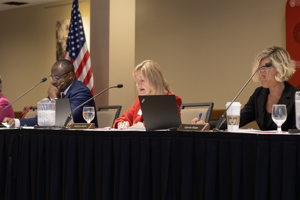Illinois State University President Aondover Tarhule held an alarming conversation about the financial state of the university at the RISE open forum that took place Monday, Nov. 18 at 10 a.m.
This was the second open forum as the first discussion took place on Thursday, Nov 14 at 2 p.m. At the forum, Tarhule addressed that ISU, due to improper budgeting, looks to face an $8.5 million deficit.
At the beginning of the presentation, Tarhule said that between administrators, there was a lot of confusion as to how the financial situation got to the point it has.
“We went through these emotions, but eventually, because we’re administrators, we realized we had to do something about this,” Tarhule said.
The same presentation was delivered in the Prairie Room at the Bone Student Center. Tarhule focused on the factors, internal and external, that impacted the current budget.
Outside ISU
Universities across the nation are facing external factors that result in less students attending college, which fuels the fire of financial problems.
Bradley University reported that they had discontinued 20 academic programs to address its $13 million budget deficit. Western Illinois University ended their 2023 fiscal year with a $12 million deficit.
Miami University, California State University, St. Cloud State university, and other universities around the nation and internationally have reported fiscal issues.
The leading effect of these problems results in expenses rising faster than revenue.
“In some ways, this might come across as an administrator speaking and apologizing,” Tarhule said as he aimed to connect university financial issues to personal financial issues.
“But the crisis that we are all facing in our private lives, the inflationary pressure that you are feeling, the fact that your money is not enough to meet all your expenses, those are the same factors that are hitting the university.”
Inside ISU
At the end of the fiscal year, ISU will see a deficit of $8.5 million. In the following year, it will increase to $10.5 million and then $14 million the year after if no action is taken.
“If we don’t act next year, we might very well be in the same situation as those other universities. Meaning that we have to start considering closing academic programs and letting staff and faculty go,” Tarhule said.
In the presentation, Tarhule discussed the issue of financial support from the state. Tarhule said that Illinois is underfunded. As Illinois students search for school, they are choosing to attend public universities out of state because it is cheaper.
ISU, according to the presentation, is one of the least funded universities in the state of Illinois. If ISU received the average funding, the university would receive $72 million more than the $67 million the state currently provides.
Additionally, despite enrollment growth, net tuition collected after accounting for financial aid, discounts and recruitment costs have declined.
“Why do we have a financial crisis if our enrollment is growing? Remember, I said: Where financial aid has gone up quite a bit, so has the cost of recruitment and tuition discount,” Tarhule said.
Tarhule showed a slide that contained scenario planning for a scarier future. The different scenarios ranged from preparation planning to crisis and existential threat planning. After he addressed the difficulties, he moved onto the future.
Solutions Addressed
After the presentation, Tarhule discussed what has been initiated along with what was planned to be put into action in the future.
Administration created a Task Force that has 34 members in charge of addressing issues. The goal of the Task Force is to develop strategies to reduce costs and diversify revenues while maintaining the core values of ISU.
Another solution included eliminating the historical budget model. Every year, the model kept the same amount of funding without adjustment. This resulted in the loss of revenue being used for better places.
“Clearly, the idea of simply saying we’re going to spend what we spent last year is not feasible,” Tarhule said.
Implementing immediate cost-saving measures was also mentioned. A few examples of these would include instituting a hiring freeze and keeping pay the same with no salary wage increases.
“We are just at the point of trying to understand the scope of our problems and what we’re going to do, so this is essentially a temporary solution,” Tarhule said. “We’ll think about what long-term strategies we need to put in place so that we can get back to being a healthy university.”
Public Comment
One member of the audience asked Tarhule about the Task Force and what the timeline for the goals would be.
Tarhule said that Interim Vice President for Finance and Planning Daniel Petree would discuss with the cabinet to go over guidelines for next year’s budget. He added that the Task Force would begin working together in a week to work together for the next year.
“We know that people need this information in advance so that they can plan, and so we are going to be working as quickly as possible to give you some guidelines,” Tarhule said.
Petree added to the answer.
“One of the things we’re counting on from our consultant is to give us information about what the best practices are,” Petree said. “They work with a number of universities successfully in this sort of change process, so I know they’re going to be able to provide us some information.”
Another question asked Tarhule to justify his administration’s avoidance of bargaining economic proposals with the United faculty and the ISU Education Association. He additionally questioned Tarhule about his $400,000 annual salary, along with the recent purchase of the College of Engineering building.
Tarhule addressed the last part of the question first. He said that the financial situation would be exactly the same whether the college was purchased or not.
Tarhule said that when they created the College of Engineering, they wrote the model in a way that would have the tuition from the students who attend the college to pay back the loan used for the purchase.
“The tuition that students pay will be used to pay that because the state is not providing us funding. This is what is called being resourceful, being creative,” Tarhule said.
Petree said because of the borrowed money used to build the college, ISU’s debt service will show up in the operating budget.
“Debt service is going to be increased by $4 million a year, so that’s something we’re going to have to take into account in our budget process,” Petree said.
Tarhule closed the forum with a statement:
“I don’t get involved in the day-to-day discussions, but I do fully understand and expect that our team is going to continue to negotiate in good faith. You can’t have a university without faculty. I know that, and anyone who has worked closely with me knows how ambitious my plans are about what this university can and should be,” Tarhule said.
“The university needs to not only survive, but it needs to thrive.”













